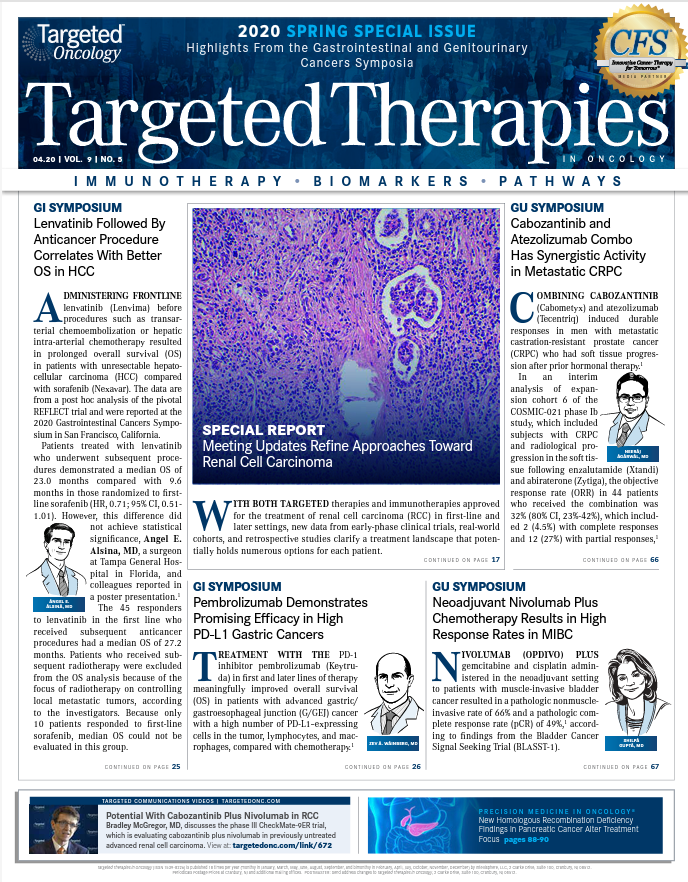Frontline Enfortumab Vedotin Plus Pembrolizumab Exhibits Activity in Advanced Urothelial Carcinoma
The updated results of the phase Ib/II EV-103 trial demonstrated that treatment-naïve patients with locally advanced or metastatic urothelial cancer who were ineligible for cisplatin-based chemotherapy showed an objective response rate of 73.3% when these patients were treated with enfortumab vedotin-ejfv in combination with pembrolizumab.<br />
Jonathan E. Rosenberg, MD

Jonathan E. Rosenberg, MD
The updated results of the phase Ib/II EV-103 trial demonstrated that treatment-naïve patients with locally advanced or metastatic urothelial cancer who were ineligible for cisplatin-based chemotherapy showed an objective response rate (ORR) of 73.3% when these patients were treated with enfortumab vedotin-ejfv (Padcev) in combination with pembrolizumab (Keytruda).1
Additionally, 45 patients treated with the combination were also evaluable for safety and efficacy. At a median follow-up of 11.5 months, results showed that the 73.3% ORR (95% CI, 58.1%-85.4%) included a 15.6% complete response (CR) rate.
“There remains a significant unmet need for patients in the first-line setting who are ineligible to receive cisplatin,” Jonathan E. Rosenberg, MD, lead author in the EV-103 study and medical oncologist and chief of the Genitourinary Medical Oncology Service at Memorial Sloan Kettering Cancer Center in New York, New York, said in his presentation at the 2020 Genitourinary Cancers Symposium. “Enfortumab vedotin [plus] pembrolizumab demonstrates encouraging activity in this patient population.”
The median duration of response (DOR) had not yet been reached (range, 1.2-12.9+ months), and the 12-month DOR rate was 53.7% (95% CI, 27.4%-74.1%). Of the 45 patients in the trial, 33 responded; 55% of the responses were ongoing at the time of the analysis, 33% of patients had progressed or died, and 12% of patients had started a new antitumor treatment before progressive disease.
For all patients, median progression-free survival (PFS) was 12.3 months (95% CI, 7.98not reached) and the median overall survival (OS) had not yet been not reached. However, the 1-year OS rate was 81.6% (95% CI, 62.0%-91.8%). The PFS rate at 12 months was 50.1% (95% CI, 33.0%-65.0%).
The combination was shown to have a manageable safety profile and no new safety signals. It had treatment-related AEs (TRAEs) similar to those observed with enfortumab vedotin monotherapy, such as rates of peripheral neuropathy (any grade, 56%; grade ≥3, 4%), rash (any grade, 62%; grade ≥3, 13%), and hyperglycemia (any grade, 11%; grade ≥3, 7%). The time to first onset for peripheral neuropathy, rash, and hyperglycemia at any grade was a median of 2.3, 0.7, and 0.5 months, respectively.
“The vast majority of these were low grade,” Rosenberg said. “And the median time at onset seemed similar to what you might expect with enfortumab vedotin alone. Eighteen percent of patients received corticosteroids for grade ≥3 immune-related AEs, also a number similar to what you might expect to see with pembrolizumab alone.”
Serious TRAEs occurred in 7 patients, but only 1 treatment-related death occurred, due to multiple organ dysfunction syndrome. The TRAEs also led to 6 discontinuations, 3 because of peripheral sensory neuropathy.
In the ongoing, multicohort, open-label, multicenter, phase Ib/II EV-103 trial, investigators evaluated the efficacy and safety of enfortumab vedotin alone or in combination with pembrolizumab in patients with muscle-invasive, locally advanced, and first- and second-line metastatic urothelial cancer. In the dose-escalation and dose-expansion phases of cohort A, patients enrolled had locally advanced or metastatic urothelial cancer who were ineligible for cisplatin-based chemotherapy.
In cohort A, patients received enfortumab vedotin intravenously on days 1 and 8 and pembrolizumab on day 1 in a 21-day cycle. At the time of the initial analysis, 45 patients (dose escalation, n = 5; dose expansion, n = 40) with locally advanced and/or metastatic urothelial cancer were treated with enfortumab vedotin at 1.25 mg/kg plus pembrolizumab at 200 mg in the frontline setting.
The primary end point of analysis is safety; key secondary end points, related to efficacy, include ORR, disease control rate, DOR, PFS, and OS
The median age was 69 years, and men accounted for 80% (n = 36) of the study population. The primary tumor location was lower tract in 69% of patients (n = 31), and metastatic sites consisted of lymph nodes in only 4 patients and visceral disease in the remaining 41 patients, including liver metastases (n = 15). PD-L1 expression status by combined composite score was <10 in 19 patients, ≥10 in 14, and not evaluable or not available in 12 patients.
“These updated data are encouraging and provide support for the recently initiated phase III trial EV-302 that includes an arm evaluating Padcev in this platinum-free combination in the first-line setting,” Roger Dansey, MD, chief medical officer at Seattle Genetics, the developer of enfortumab vedotin, stated in a press release.
Investigators presented initial results of this EV-103 cohort during the European Society for Medical Oncology Congress 2019.2Here the combination of enfortumab vedotin and pembrolizumab led to an ORR of 71%, including a 13% CR rate. Moreover,
the stable disease rate was 22%, leading to a clinical benefit rate of 93%. Two patients were not evaluable for response status; 1 patient had progressive disease as a best response. All but 3 evaluable patients had some degree of tumor shrinkage.
Additional urothelial cancer cohorts of EV-103 will evaluate enfortumab vedotin: alone or in combination with pembrolizumab or a platinum-based chemotherapy in the first-line setting for patients with metastatic disease, plus pembrolizumab and carboplatin or cisplatin in first-line metastatic disease, alone or in combination with pembrolizumab in muscle-invasive disease, in combination with pembrolizumab in second-line metastatic disease, and plus gemcitabine in first- or second-line metastatic disease.
In December 2019, the FDA granted an accelerated approval to enfortumab vedotin for the treatment of adult patients with locally advanced or metastatic urothelial cancer who have received prior treatment with a PD-1/PD-L1 inhibitor and platinum-containing chemotherapy.3
References
- Rosenberg JE, Flaig TW, Friedlander TW, et al. Study EV-103: preliminary durability results of enfortumab vedotin plus pembrolizumab for locally advanced or metastatic urothelial carcinoma.J Clin Oncol. 2020;38(suppl 6; abstr 441). doi: 10.1200/JCO.2020.38.6_suppl.441
- Hoimes C, Rosenberg J, Srinivas S, et al. EV-103: initial results of enfortumab vedotin plus pembrolizumab for locally advanced or metastatic urothelial carcinoma.Ann Oncol. 2019;30(suppl 5):v356-v402. doi: 10.1093/annonc/mdz249.
- FDA grants accelerated approval to enfortumab vedotin-ejfv for metastatic urothelial cancer. FDA website. bit.ly/2INM3Cf. Updated December 19, 2019. Accessed March 16, 2020.

Survivorship Care Promotes Evidence-Based Approaches for Quality of Life and Beyond
March 21st 2025Frank J. Penedo, PhD, explains the challenges of survivorship care for patients with cancer and how he implements programs to support patients’ emotional, physical, and practical needs.
Read More